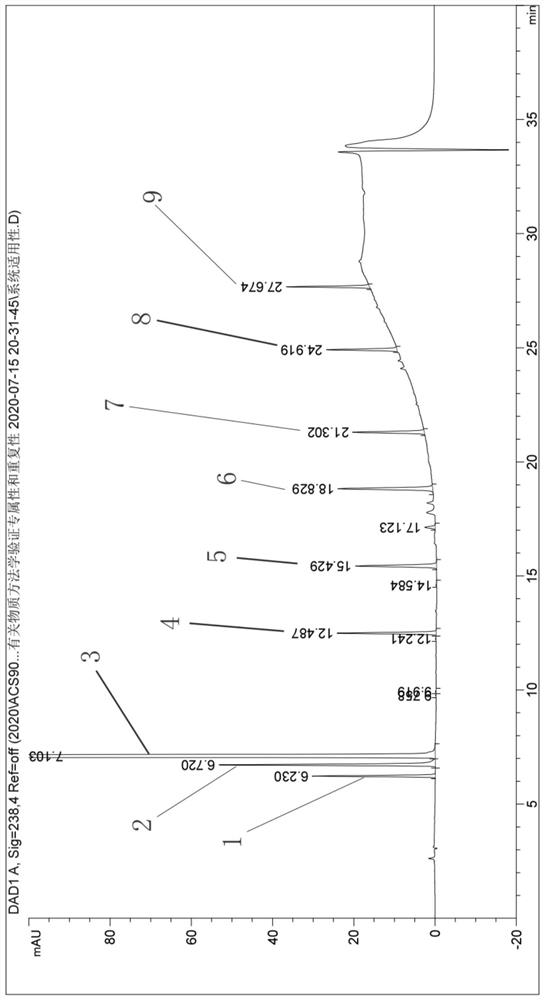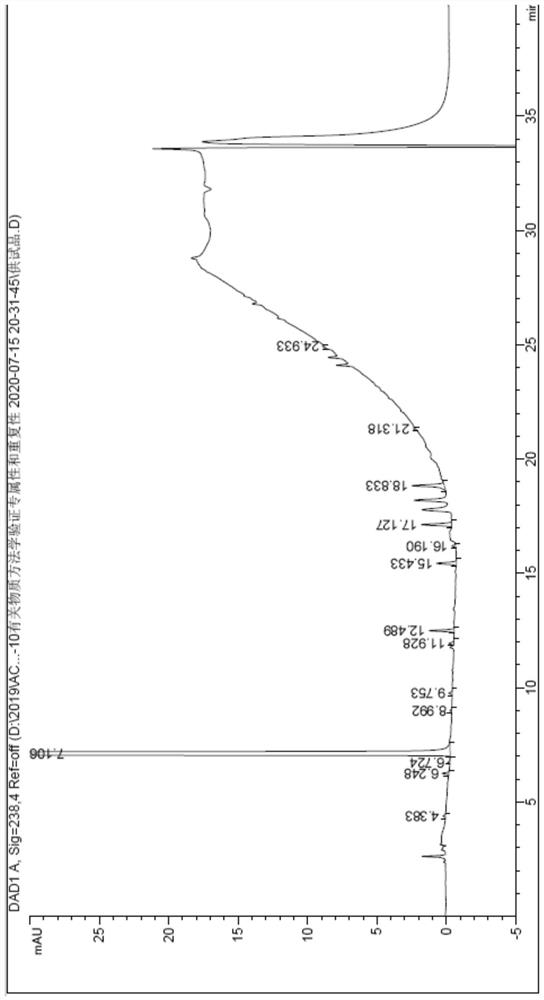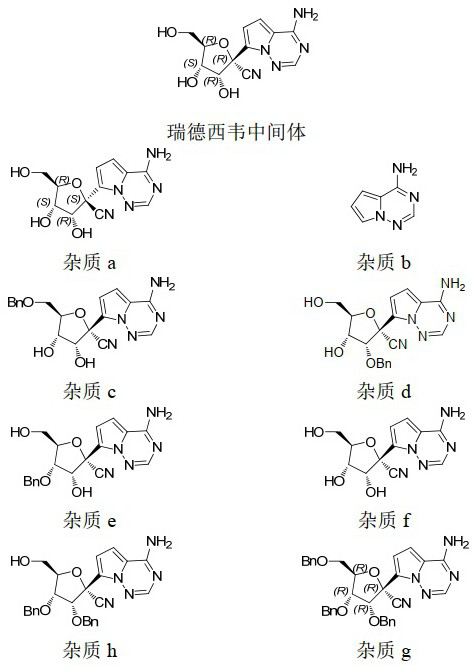A detection method for related substances of remdesivir intermediate
A detection method and technology for related substances, which are applied in the field of detection of related substances in intermediates of remdesivir, can solve the problems that there is no detection method for related substances in intermediates, and achieve the effects of stability, strong adaptability, and easy operation
- Summary
- Abstract
- Description
- Claims
- Application Information
AI Technical Summary
Problems solved by technology
Method used
Image
Examples
Embodiment 1
[0039] Example 1: Specificity test
[0040] 1. Detection of chromatographic conditions
[0041] Chromatographic column: C18 (250mm×4.6mm, 5μm);
[0042] Detector: Diode Array Detector (DAD);
[0043] Detection wavelength: 238nm;
[0044] Flow rate: 1.0ml / min;
[0045] Column temperature: 30℃;
[0046] Diluent: 0.1% phosphoric acid water-methanol (95:5);
[0047] Injection volume: 5 μl.
[0048] 2. Preparation of reference substance and test solution
[0049] The specificity test needs to verify that the blank solution has no interference at the retention time of the main peak in the test solution and the reference solution, as well as the resolution between the impurities and the main components.
[0050] The following is the preparation method of each impurity and main component:
[0051]Impurity a positioning solution: Precisely weigh 15 mg of the impurity a reference substance, put it in a 50 ml volumetric flask, add 5 ml of methanol, add 0.25 ml of 85% phosphoric a...
Embodiment 2
[0067] Example 2: Sensitivity test
[0068] Take the system suitability solution prepared in Example 1, dilute it to appropriate multiples step by step, take the solution with signal-to-noise ratio ≥ 10:1 as the limit of quantitation solution; take the solution with signal-to-noise ratio ≥ 3:1 as the limit of detection solution.
[0069] Referring to the detection chromatographic conditions of Example 1, 5 μl of each of the above solutions were accurately measured and injected into a liquid chromatograph, 6 injections of the limit of quantification solution and 1 injection of the detection limit solution were performed continuously, and the chromatogram was recorded. The results are shown in Table 2~ table 3.
[0070] Table 2 Validation results of the limit of quantification
[0071] name Concentrationμg / ml S / N Sensitivity (%) Impurity a 0.11708 24.68 0.05 Impurity b 0.11746 38.48 0.05 Intermediate 0.12240 21.07 0.05 Impurity c 0....
Embodiment 3
[0075] Example 3: Repeatability test
[0076] Test solution: Weigh about 12.5mg of the test product, put it in a 50ml volumetric flask, first add 5ml of methanol, then add 0.25ml of 85% phosphoric acid, ultrasonically dissolve it, dilute it with mobile phase A to the mark, shake well, 6 servings were prepared in parallel.
[0077] With reference to the detection chromatographic conditions of Example 1, 5 μl of each of the above solutions were accurately measured, injected into a liquid chromatograph, and the chromatogram was recorded. The results are shown in Table 4.
[0078] Table 4 Repeatability investigation results
[0079]
[0080]
[0081] Note: "ND" means not detected.
[0082] It can be seen from Table 4 that the number of impurity peaks above the quantitative limit remains unchanged, and the RSD of single impurity content and purity meet the requirements (the RSD of each impurity with a content of less than 0.5% is not greater than 10.0%; The RSD of each imp...
PUM
| Property | Measurement | Unit |
|---|---|---|
| concentration | aaaaa | aaaaa |
| wavelength | aaaaa | aaaaa |
| length | aaaaa | aaaaa |
Abstract
Description
Claims
Application Information
 Login to View More
Login to View More - R&D
- Intellectual Property
- Life Sciences
- Materials
- Tech Scout
- Unparalleled Data Quality
- Higher Quality Content
- 60% Fewer Hallucinations
Browse by: Latest US Patents, China's latest patents, Technical Efficacy Thesaurus, Application Domain, Technology Topic, Popular Technical Reports.
© 2025 PatSnap. All rights reserved.Legal|Privacy policy|Modern Slavery Act Transparency Statement|Sitemap|About US| Contact US: help@patsnap.com



